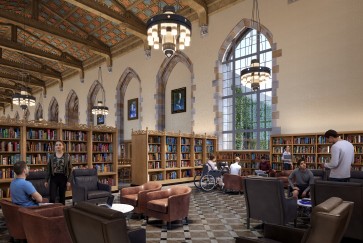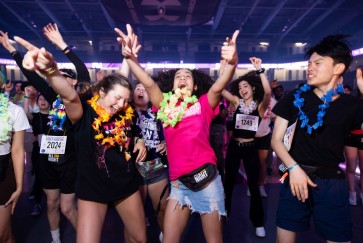More than two years ago when performance studies professor Ramón H. Rivera-Servera launched the Puerto Rican Arts Initiative, his goals were simple: save and revitalize the art community on his native land devastated by two hurricanes and to help individual artists develop their own work.
A $500,000 grant from The Andrew W. Mellon Foundation provided the funds necessary to get that urgent work started. Ten artists and their mentor pairs were able to develop and mount new works on the island, even in the midst of a global pandemic. The initial funds also established artistic residencies at Northwestern and other colleges and universities.
Turns out, that was only the beginning of a much bigger mission for PRAI.
Phase two: artists helping artists
We're trying to make sure that all of the wonderful artists who are advancing new practices and the artists who have done their entire careers here without being recognized will both gain recognition.”
Founder, PRAI
As a bonus in the second phase of the program, each artist also has the ability to invite between four and ten additional artists to help them develop their work. The new funding also supports seven short-term projects that invites two artists to work within each of those projects. PRAI is also sponsoring five workshops that are extended training sites designed to advance knowledge and technique around performance art practices and other ephemeral arts in Puerto Rico.
Up to 120 artists could be touched when PRAI’s second phase concludes next year.
New collaboration with University of Texas
Since 2015, Ramón H. Rivera-Servera has been spearheading efforts to support contemporary performance practice and research in Puerto Rico, including a series of developmental residencies at Northwestern for artists engaged in the decades-long debt crisis on the island. 
Northwestern School of Communication Dean E. Patrick Johnson says this new collaboration will strengthen efforts to boost black and brown artists in the United States, but also in the broader black diaspora, including Puerto Rico.
“What Ramón and I were able to create at Northwestern was just a microcosm of a broader collaborative community of artists of color, scholars of color around the arts, and the black diaspora,” Johnson said.
“UT has also been an institution with which Northwestern has collaborated over the years. With Ramon becoming dean, there's a natural synergy there that will make that collaborative spirit even more formal with the College of Fine Arts there and our school. With the Black Arts Consortium, UT can be a natural outpost for the collaborations that BAC was already planning to initiate and inaugurate with various institutions.”
(Above: See an example of PRAI's impact on a community center in San Juan.)While on a recent visit to Puerto Rico to celebrate the close of a successful phase one of PRAI, Ramón Rivera-Servera shared his thoughts with Northwestern Now about the exciting future of the initiative.
Explain how phase two of the Puerto Rican Arts Initiative will be a boost to the arts community on the island.
This version focuses on three key curatorial engines. As you know, Puerto Rico has been distinctly affected by climactic change and other environmental stressors, starting from the hurricanes that initiated our engagement, to the earthquakes that affected the island a year ago, to now a pandemic. So ecological politics is key to this approach. Second, we're also focused on community infrastructures and affects. One develops after the other in the sense that we're interested in artists who are working with their communities and organizations to build up their collective efforts. This includes a number of artists who take decommissioned or abandoned schools or residential or commercial buildings, and reactivate them by creating cultural centers, artists, studios, and galleries, theaters, and so on. We attached that infrastructure to affects because those buildings provide space for gatherings but also allow for the emotional commitment to the collective. The third one is our rights to the city. Right now, Puerto Rico is being heavily gentrified by external forces, primarily American investors in real estate, and a rapidly growing tourist sector, intensified by the pandemic lockdown on international travel. It is really important for us as Puerto Ricans, but also black, working-class queer, women, immigrants, and other minoritarian folks to be able to claim the right to the urban core, to its facilities, to its spaces of assembly. We have been working with artists that work with activist organizations to be able to improve the quality of life for communities generally left out of the glitzy, touristy, gentrified parts of the urban core. We're investing in artists that move beyond traditional scenes or markets for visual and performing arts.
What kind of impact did the hurricanes have on the artist community in Puerto Rico?
A significant number of artists have relocated, but also a significant number of community theater and performance projects and interesting art spaces started to emerge elsewhere on the island. So, we're at a really interesting moment in the sense that whether we wanted it or not, the hurricanes brought a lot of disaster but also a lot of visibility to this place. Art institutions and organizations started to engage because of the urgent rescue framework and then found the amazing work that has been done here. It's really about the great opportunity of learning and appreciating the amazing artistry that is being produced here in Puerto Rico. We're all trying to make sure that all of the wonderful young artists who are advancing new practices and the artists who have done their entire careers here without being recognized will both gain recognition.
Is the goal to elevate Puerto Rico’s standing on a world stage?
My goal is to make sure that the important public forum that the arts create in Puerto Rico continues. I feel like we have to enlist the cooperation of the world in recognizing the significance of our artistic contributions. But the world is never my focus. My focus here is Puerto Rico, and the locality and what these communities can do.
What would you say is the biggest social impact of the Puerto Rican Arts Initiative has been so far?
I think the most important thing is that we got a community of artists to start thinking and doing together. We have real diversity of the places from where each of these artists come. Some come from an established dance practice. Others come from theater or the visual arts. I feel the biggest impact we’ve had is to help the artists share their knowledge with other artists. Where do they identify resources? What are their strengths and weaknesses? How do they secure funds, sponsorships or spaces? We were realizing that artists can continue with the practice as long as they garner resources, but they need real skills on how to garner those resources and how to sustain the work and how to present it for circulation. In this second phase, are really betting on formalizing those networks by promoting projects that initiate some kind of network opportunity. So, it's not just, “here's some money, go do your work.” It's like, “here's some money, go do your work, and learn how you can continually grow and help other people along with you.”
You're becoming the dean of the College of Fine Arts at UT Austin. What does that mean for the future of the Puerto Rican Arts Initiative and its connection to Northwestern?
This second phase of the Puerto Rican Arts Initiative will be a collaborative project between the University of Texas at Austin and Northwestern University with the support of the Andrew W. Mellon Foundation. It is my hope that that this project becomes one of a few other projects that will continue my active, productive relationship with Dean E. Patrick Johnson as collaborative scholars, curators, and now academic leaders. I'm moving from Northwestern, but I don't feel like I'm fully departing Northwestern because I still have my colleagues there. I still have some of my students completing their degrees here. Two of them, José Alvarez Colón and Arnaldo Rodríguez Bagué, are from Puerto Rico themselves and will continue to be my co-investigators in this project. Dean Johnson and I, in my new role at UT, should be able to continue collaborating and amplifying the good work that we have done over the past 14 years. I'm hoping that Puerto Rico will remain of importance to the two of us, and the kinds of things we do in the years to come.

